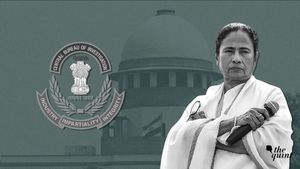Former Kentucky Sheriff Pleads Not Guilty to Murdering Judge
Former Sheriff Shawn "Mickey" Stines, aged 43, appeared for his arraignment on November 25, 2024, pleading not guilty to the murder of District Judge Kevin Mullins. This courtroom drama unfolded at the same facility where both men had worked closely together for many years before the tragic incident.
The indictment against Stines emerged just days prior, following the shocking shooting on September 19 at the courthouse located in Whitesburg, Kentucky, approximately 100 miles southeast of Lexington. Having served as sheriff for multiple years, Stines resigned immediately after the shooting. He now faces the severe charge of murdering a public official, with the possibility of the death penalty looming should he be convicted.
Judge Julia Adams presided over the arraignment and, citing significant community safety concerns and the serious nature of the accusations, denied Stines bail. The judge expressed her belief this was necessary due to the gravity of the charges, which are classified as capital offenses. Stines appeared visibly emotional, gesturing toward his family present in the courtroom, reportedly saying, "I love you all," as he was led away after the proceedings.
The incident has sparked intense local and national interest. Surveillance footage from inside the courthouse shows Stines pulling out a gun and firing at Mullins, who was seated at his desk. After Mullins fell, Stines approached him and shot him again. Witnesses recounted the unsettling scene, with some family members of the victim visibly shaken during the hearing.
Mullins, who had been serving as judge for 15 years, died on-site, with law enforcement confirming he suffered multiple gunshot wounds. A Kentucky State Police detective revealed earlier testimonies indicating Stines attempted to reach out to his daughter on both Mullins’ phone and his own just before the shooting took place. Confounding the situation, no weapon was found on Judge Mullins or within his chambers at the time.
On the day of the tragic shooting, Stines and Mullins were allegedly seen having lunch at a nearby restaurant along with several others, raising questions about the motive behind the attack. Despite the shock and outrage surrounding the incident, officials have not disclosed any clear motive for this tragic act of violence.
Notably, this case has drawn considerable public and media attention, with many expressing incredulity over the involvement of someone who once upheld the law. The courthouse represented not just the center of legal proceedings but also the community’s trust and order, elements now deeply shaken by this event.
Following the hearing, court security and local law enforcement heightened their presence, ensuring safety within the courthouse as proceedings evolve. Many individuals within the community, particularly those who knew both men, have reflected on the impact this shooting has had, narratively grappling with feelings of disbelief.
Public discourse around the case continues to expand, as does the scrutiny on former Sheriff Stines’ actions leading up to the shooting. Observers are left wondering what drove him to this altercation, and the absence of a clear motive leaves many unanswered questions. Stines will remain detained as the legal process continues, leading up to what promises to be pivotal upcoming court dates.
Traditionally, the roles of sheriff and judge connote mutual respect and cooperation; the relationship between Stines and Mullins had exemplified this until the tragedy unfolded. Community members and legal experts alike are urging for transparent investigations and legal proceedings to deliver justice, not only for the late Judge Mullins but also for the collective conscience of those unsettled by the event.
Many individuals, including the family of Mullins, have requested answers as the legal proceedings advance. Discussions have also arisen around the broader societal issues related to gun violence and safety, particularly within courthouse settings. The gravity of the situation continues to weigh heavily, with citizens advocating for comprehensive evaluations of workplace safety, particularly for public officials.
Image and memory of Judge Mullins linger heavily within the community. People are rallying not only to seek justice for his untimely death but are also calling for action to prevent future violence. The courthouse where these tragic events transpired bears witness to the dual roles of comfort and calamity, challenging all who enter to reconcile the ideals of justice and safety.
Emotions are heightened across Whitesburg as residents process this painful chapter, determined to come to terms with how such violence could transpire among those charged with upholding the law. Vigilance and remembrance dominate discussions among those affected and within wider legal circles.
While the future of Stines hangs precariously beneath the impending legal judgment, the case remains under intense media scrutiny. Stines' next court appearances will likely attract significant attention as the community braces for the development of this high-profile murder case.
Legal experts suggest the proceedings could take several months, but just as the situation remains fluid, so do the emotions of all involved. The courtroom's atmosphere during his arraignment revealed not only the seriousness of the charge but the deep-seated pain felt throughout the community.
Whether he will be convicted remains uncertain, but what is clear is the imperative for the community and the legal system to work together during this trying time. The tragedy transcends the individuals directly involved and serves as a poignant reminder of the risks faced by public officials and the intense scrutiny of the institutions meant to serve justice.
Public interest continues to swell around the case as more information becomes accessible, highlighting the intersection of criminal justice, public trust, and community responses to violence. The memory of Judge Mullins endures, compelling many to reflect on his legacy amid the chaotic events surrounding his death.”



